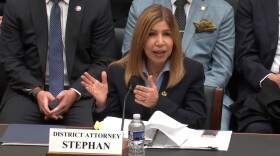The migrant camp in El Chaparral plaza in Tijuana has only grown in recent weeks.
Hundreds of asylum-seekers, from Central America, from Africa, from the Caribbean, wait for the day the United States fully restores its asylum system along the southwest border — a system first turned on its head by the Trump administration, stopped entirely during the pandemic, then only haltingly reconstituted by the Biden administration.
But for the first time since the camp sprung up in February, there’s some hope. A few families who had been living here are getting into the United States, escaping the cramped and dangerous spaces of the haphazard camp.
“These are terrible conditions. You have kids just running around. It wasn’t until recently that the local government put in bathrooms and showers,” said Pedro Rios with the American Friends Service Committee. “It’s been a struggle for them.”
The American Friends Service Committee is one of the few groups still making trips to the camp, to offer support, face masks, hygiene kits, and some advice, about this new way to safely enter the United States.
It’s part of a deal struck between the American Civil Liberties Union and the Biden Administration, stemming from a lawsuit challenging a migrant expulsion policy known as Title 42. The deal now allows for 250 families or individuals to enter the United States along the southwest border each day, to pursue their asylum claims.
RELATED: Deported Mother Of Army Officer Allowed To Reunite With Family
Deciding who ends up on the list that gets sent to the U.S. government is up to these service providers on the ground in Tijuana. Groups including Al Otro Lado and Casa del Migrante have been working with migrants in the camp and nearby shelters to help identify some of those 250 individuals.
It’s based not on their claims of asylum from their home countries, but how much danger they face in Mexico.
“You can imagine how many petitions are being handled at this time just at this port of entry alone,” Robert Vivar says, as a crowd gathers around him. Vivar is with Unified U.S. Deported Veterans. His office is just down the block from the camp.
Dozens of desperate people ask him when they’ll get a call back from overworked immigration lawyers, or they tell him their child is sick, and in danger. There’s just no way for Vivar to help everyone, but he’s trying.
“It’s kind of difficult to tell people to have patience, when they’re running away because of persecution, but it’s not safe, even here they’ve had threats, they’ve been followed. You can understand why they’d be so desperate for information,” he said.
Right now, the focus has been to locate pregnant women, people with pressing medical needs, and those in immediate danger in Mexico. But migrants without working papers, or homes, are constantly under threat in Mexico.
Rafa Enterreano, a member of the LGBTQ community, is one of those people who could have a strong asylum case, were he allowed into the U.S. He says he fled Honduras after his house was burned down, he was beaten and his friends were killed.
He’s been living in Tijuana for more than a year, waiting to enter the United States.
Under the current arrangement, he’s not being prioritized, though.
“It’s been hard because the volunteer lawyers that do come, they’re only accepting applications for families, for kids, for people with illnesses or who have terminal cancers,” he said in Spanish. “For many LGBT people, we don’t have representation. No one. It’s very difficult, to be alone in this situation.”
Every morning and afternoon, Customs and Border Protection agents call out names at the port of entry in Tijuana. Late Thursday afternoon, several families entered the United States, to begin an asylum process that will take years to resolve.
Dulce Garcia, the executive director of Border Angels, spent three weeks working in the encampment, finding the people who can get to safety now. She’s now helping them from the U.S. side of the border.
“People are now saying, 'the tent next to me is leaving because they’re crossing over to the United States finally.' And that brought hope to people in the encampment, which also made people a lot more desperate to have their cases heard first,” she said.
Garcia hopes that this system won’t last much longer — pressure is growing on the Biden administration to drop Title 42 and restore the asylum system along the border.
Until that happens, the encampment at El Chaparral won’t be going anywhere, Robert Vivar says. “As more people leave, more people take their spot.”








